 source: anandtech.com
source: anandtech.comWelcome to Fall 2009 IDF week! As usual, Intel has a ton of stuff to discuss at the Intel Developers' Forum (IDF). Most of the truly exciting stuff shows up first on the desktop - things like Larrabee and Sandy Bridge. Those of us who dwell more in the mobile market tend to get leftovers, but sometimes things taste better after they've had some time to age properly.
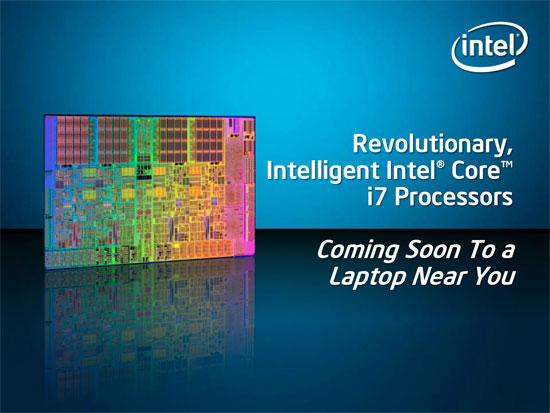
Not quite one year since the official launch of Nehalem for desktops and servers, Core i7 is officially making its way to notebooks. The processor is called Clarksfield, but it's essentially a mobile variant of Lynnfield. If you haven't read anything about Lynnfield, you might want to start with our thorough look at the desktop CPUs. Of course, there are some differences between Clarksfield and Lynnfield. Lynnfield processors use LGA-1156 for example, while the mobile Clarksfield uses a smaller 989-pin socket. Clarksfield also comes with new model numbers, naturally.
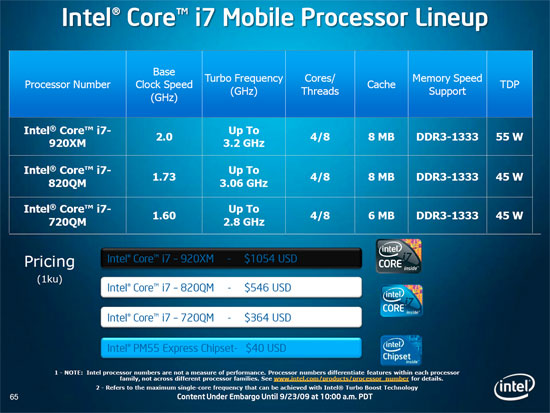 |
Initially, Clarksfield is launching in three variants: i7-920XM, i7-820QM, and i7-720QM. The i7-920XM is an Extreme Edition processor, designed to replace the Core 2 Extreme QX9300. Like all Extreme processors, the i7-920XM carries a price tag of around $1000. If you want the latest and greatest, it's going to cost you. The i7-820QM drops performance slightly and cuts the price in half, with the i7-720QM as the "affordable" alternative. Unlike Lynnfield, all of the current Clarksfield parts have Hyper-Threading enabled. The Turbo modes are also aggressive on all of the models, but multi-core performance will definitely favor the i7-920XM.
| Codename | Market | Cores | Manufacturing Process |
| Bloomfield | Desktop | 4 | 45nm |
| Lynnfield | Desktop | 4 | 45nm |
| Clarkdale | Desktop | 2 | 32nm |
| Clarksfield | Mobile | 4 | 45nm |
| Arrandale | Mobile | 2 | 32nm |
One of the interesting presentation points from Intel concerns the question of why Clarksfield is important - after all, don't most people just use a desktop anyway? Intel provided the following slide:
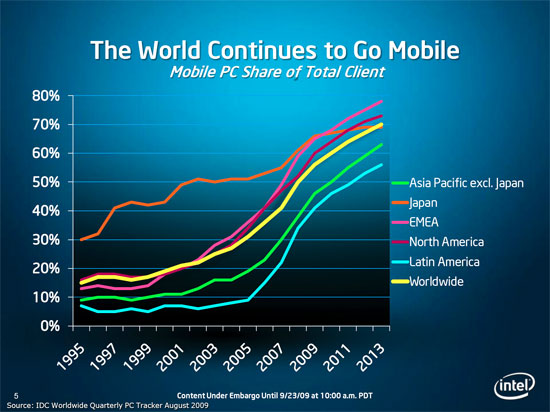
There will always be a case for using desktops (and servers, workstations, etc.), but there's a growing trend in the world to move towards laptops. The gap between desktops and laptops has always been rather large, and honestly it still is. The fastest laptops currently available are about equal to what you could get on the desktop at least two years ago, give or take. Getting mobile i7 CPUs at least narrows the gap somewhat. Comparing Clarksfield and Lynnfield, maximum base clock speeds favor desktops by just under 50% while Turbo speeds for a single core bring Clarksfield within 13% of Lynnfield. While that's nice, it doesn't change the fact that desktop GPUs are still a couple generations ahead of the mobile parts.
Anyway, we are here to talk about Clarksfield today. This is a first look as we are still performing additional tests - yes, we have a Clarksfield notebook - but we will follow up with a complete review of the highest performing notebook solutions. For now, let's quickly go over the Clarksfield basics, look at some of the material from Intel, and compare performance in a few benchmarks.
Clarksfield Platform
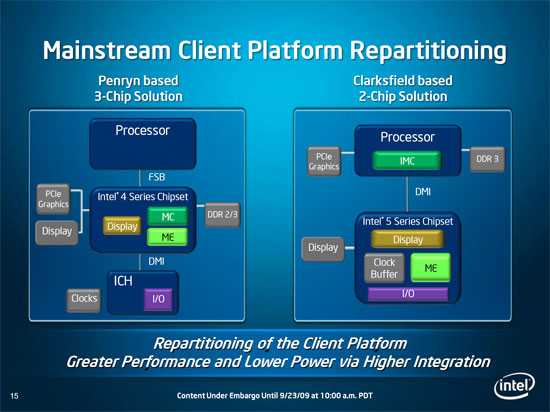
As mentioned, Clarksfield bears a striking resemblance to Lynnfield. The core architecture is the same, and the chipset is essentially the same as well - it's just a mobile version of the P55 chipset, the PM55. The processor has an integrated memory controller and PCI-E x16 connection, while the PM55 chipset handles the rest.
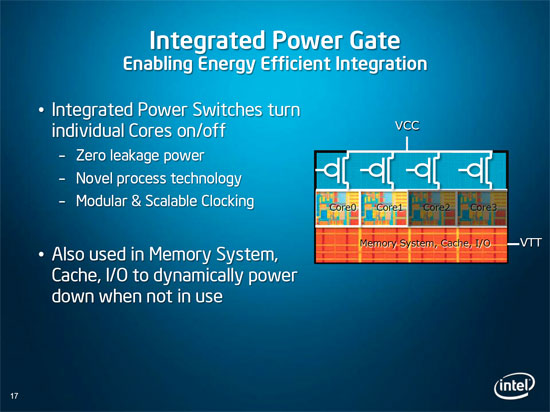
One of the major benefits of Nehalem on the desktop is that it is extremely efficient when you're not taxing the CPU. This comes courtesy of Intel's Power Gate transistors, and as you would expect it's going to prove extremely useful on laptops. Now we can finally get high-performance laptop CPUs that don't kill battery life. If you are only doing minor document editing, your quad-core processor can just shut down three of the cores to conserve power.
We have noticed in testing that current quad-core CPUs require noticeably more power than dual-core parts, resulting in relatively poor battery life on any quad-core notebook. Clarksfield should help to address that issue, although the CPU can still consume quite a bit of power under full load. That's going to make things a little difficult, since we now have a CPU that can use very little power when idle but it can suck down as much - or more - power than a Core 2 Quad QX9300 at full throttle. That means Clarksfield is going to be destined more for desktop replacements as opposed to thin and light laptops; we'll need the dual-core Arrandale (the mobile equivalent of Clarkdale) before we see 35 W and 25 W mobile parts. (What we really want to see is Power Gate transistors used on GPUs…. Ed: Something that will be coming in the next couple of years)
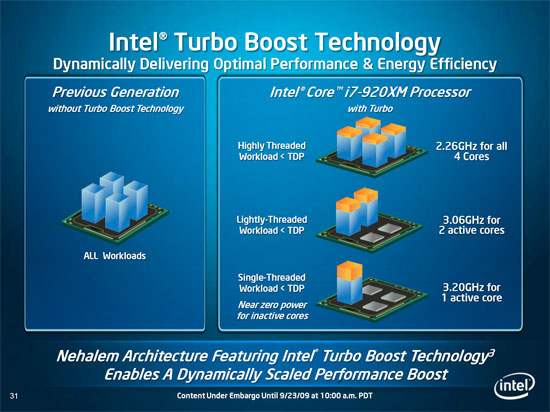
One of the major innovations with Lynnfield is the aggressive Turbo modes, which allow you to get a quad-core processor that also works as an extremely fast dual-core or single-core CPU. The desktop i7-870 offers relatively impressive Turbo modes, allowing the CPU to scale from 2.93 GHz up to 3.6 GHz depending on what sort of load it's currently running. Put another way, the i7-870 can run at up to five bins above its rated clock speed. The mobile i7-920XM has a much lower base clock speed of just 2.0 GHz, but it has even more aggressive Turbo modes, allowing a single-core to scale up to 3.2 GHz - a boost of nine bins! The maximum dual-core boost is also much higher than on Lynnfield, allowing the i7-920XM to run at eight bins above stock with two active cores. Only with three or four active cores are the Turbo modes limited to a two-bin increase.
The following three slides summarize what you get with Clarksfield: basically a mobile version of Lynnfield and P55.
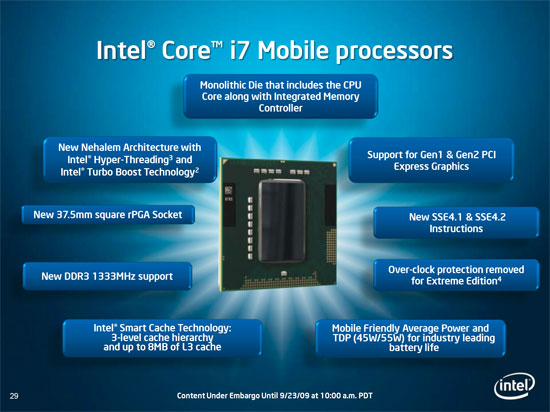
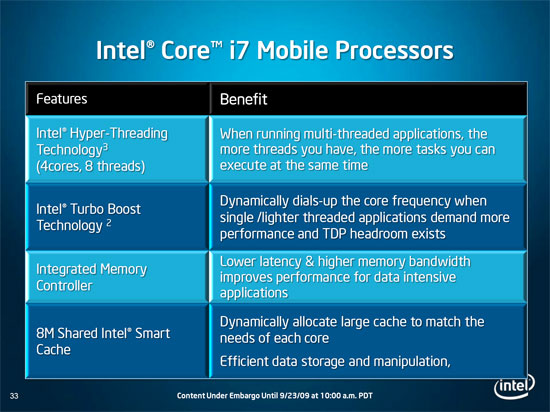
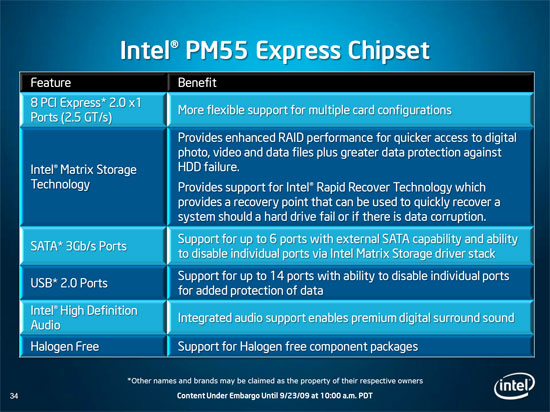
The bottom line is that Clarksfield is all about performance. Nehalem can be very stingy when it comes to power use, but as we will see later maximum power draw can still be very high. If you're looking for a new laptop that will get Intel Atom levels of battery life, Clarksfield definitely isn't going to fit the bill. What it should offer is better performance within the same power envelope as previous processors, so instead of a QX9300 you can get an i7-920XM.
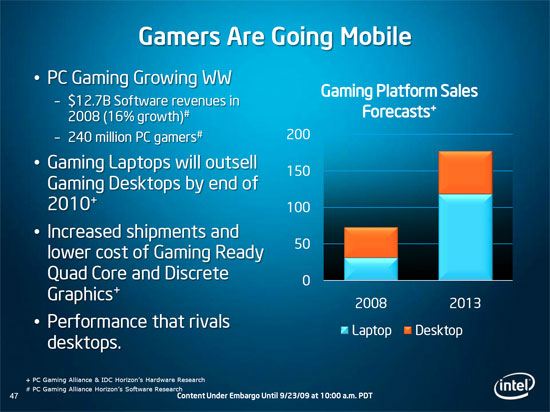
One final slide from Intel that I had to pull out shows that marketing as usual is getting a little carried away. I suppose the real question is what qualifies as a "gaming laptop", but as someone who regularly reviews high-end laptops I'm relatively certain they're not getting any closer to displacing gaming desktops for the vast majority of users. When you can purchase a $1000 desktop that offers 2-3x the performance of even the fastest $3000+ "gaming laptops", that's a tough pill to swallow. Needless to say, just because a laptop has "DirectX 10 capable" graphics doesn't mean it's a "gaming laptop". I would argue that anything less than the GeForce 8800M/9800M/GTX 260M hardly qualifies as a gaming solution, but then some people are more than happy to make do with AMD's HD 3200.
Okay, enough talk… let's see some actual performance numbers.
Test Setup
For this initial look, we're only going to include a subset of our performance benchmarks. Normally we would include results from PCMark, but the Clarksfield system shipped with an SSD and the other test systems have their own take on storage, making PCMark results meaningless. We all know SSDs are faster at certain tasks, but without using the same SSD in all three systems we can't really compare performance. That's part of the reason why this is only an abbreviated preview; we have a lot more benchmark results, but we're not just comparing CPU performance. We will have a complete review of all three notebooks in the near future, where we will go into further details about configuration options. For now, here's the skinny on what we are testing.
| Clevo W87CU Test System | |
| Processor | Intel Core i7-920XM (2.0GHz 55W TDP) (Quad-core + Hyper-Threading, 45nm, 4x256K L2, 8MB L3) |
| Memory | 2x2048MB PC3-10700 @ DDR3-1333 9-9-9-24 |
| Graphics | 1 x NVIDIA GTX 280M (Driver Version 186.81) |
| Display | 17.3" Glossy WXSGA+ (1600x900) |
| Hard Drive | OCZ Vertex 120GB SSD |
| Optical Drive | 8x SATA DVDR |
| Battery | 6-cell, 11.1V, 3800mAh, 42.18Wh |
| Operating System | Windows Vista Home Premium SP1 64-bit |
| Eurocom M980NU XCaliber Test System | |
| Processor | Intel Core 2 QX9300 (2.53GHz, 45W TDP) (Quad-core, 45nm, 2x6MB Shared L2) |
| Memory | 2x2048MB PC3-10700 @ DDR3-1333 9-9-9-24 |
| Graphics | 2 x NVIDIA GTX 280M (Driver Version 186.03 SLI/186.81 No SLI) |
| Display | 18.4" Glossy 1080p (1920x1080) |
| Hard Drive | Seagate 500GB 16MB 7200RPM (Momentus 7200.4 ST9500420ASG) |
| Optical Drive | 8x SATA DVDR/BD-ROM |
| Battery | 9-cell, 14.8V, 4650mAh, 68.82Wh |
| Operating System | Windows Vista Home Premium SP1 64-bit |
| AVADirect Clevo D900F Test System | |
| Processor | Intel Core i7-975 (3.33GHz, 130W TDP) (Quad-core + Hyper-Threading, 45nm, 4x256K L2, 8MB L3) |
| Memory | 3x2048MB PC3-8500 @ DDR3-1066 7-7-7-20 |
| Graphics | 1 x NVIDIA GTX 280M (Driver Version 186.81) |
| Display | 17.0" Glossy WUXGA (1920x1200) |
| Hard Drive | 2 x OCZ Vertex 30GB SSDs in RAID 0 Seagate 500GB 16MB 7200RPM (Momentus 7200.4 ST9500420AS) |
| Optical Drive | 8x SATA DVDR |
| Battery | 12-cell, 14.4V, 6600mAh, 95.04Wh |
| Operating System | Windows Vista Home Premium SP1 64-bit |
Clevo's W87CU is our Clarksfield test platform. Unfortunately (fortunately), Intel shipped it to us with their 80GB SSD and Windows 7. That creates a couple problems. First, all of our previous laptop results come from Windows Vista, and as we recently showed, your choice of OS makes a difference. Since we wanted to try to compare apples-to-apples, we replaced the OS with Vista on our own OCZ Vertex 120GB SSD (our disk cloning software wouldn't work with the W87CU hardware, so we left the original Windows 7 installation alone - we will go back to it in a later review). The system ships with a single GTX 280M.
Representing the old guard, Eurocom's M980NU XCaliber uses a Core 2 Extreme QX9300 - the pinnacle of laptop performance prior to the launch of Clarksfield. The CPU is paired up with two GTX 280M graphics cards in SLI, all stuffed into a gigantic 18.4" chassis. This is essentially the NVIDIA equivalent of the 4870X2 ASUS W90Vp, with a slightly faster CPU. (Remember that the W90Vp allows an easy overclock to 2.27GHz.) We will also test performance with SLI disabled in order to compare results with the other two notebooks.
The final entrant in our benchmarks today really muddies the waters. The Clarksfield i7-920XM is the fastest mobile CPU currently available, which makes the Clevo W87CU the fastest notebook available, right? Well, no, since Clevo already went and stuffed a desktop i7 Bloomfield CPU into their D900F - and not just any Bloomfield CPU; the D900F supports everything up to the top-end i7-975. AVADirect was kind enough to send us just such a system for review, and it also ships with a single GTX 280M. It also has dual 30GB SSDs for the primary drive, providing a ton of bandwidth for data transfers.
What we have are three top-of-the-line desktop replacement notebooks, using the three fastest CPUs you can find in a notebook (even if one of them is a desktop CPU). All of the systems use NVIDIA's GTX 280M, so when we look at graphics performance we can remove the GPU as a factor and see how the CPUs impact frame rates - if at all.
System Performance
We'll begin with a look at general system performance using applications that can take advantage of the multi-core processors.
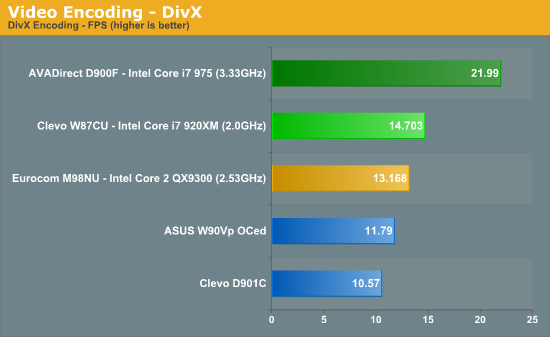
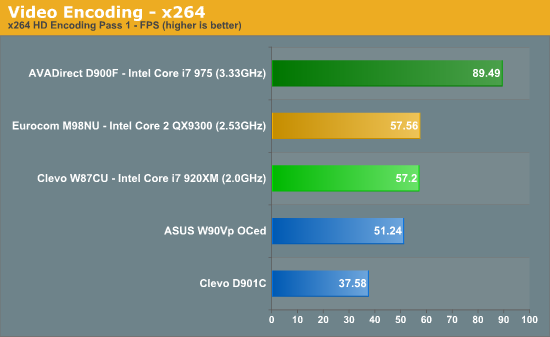
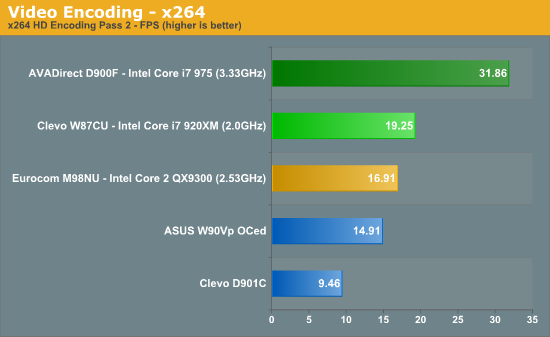
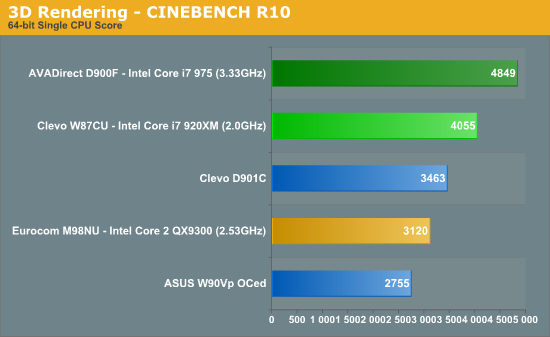
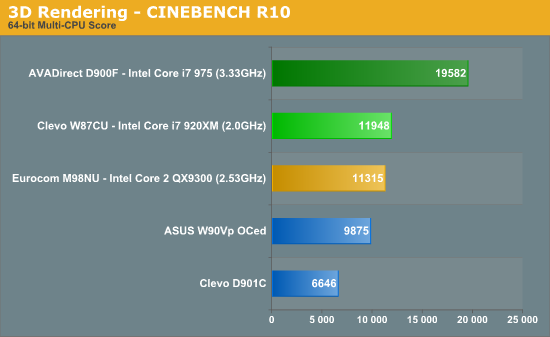
Application performance is about what you would expect given the CPU specifications. The new Clarksfield i7-920XM isn't substantially faster than the old Core 2 QX9300 when it comes to running highly threaded code. The problem is that when running highly threaded code, Clarksfield's Turbo modes aren't able to fully activate. We end up with a Core i7 running at 2.26 GHz compared to a Core 2 running at 2.53 GHz, and overall performance is relatively close. Clarksfield is 6% faster in SMP CINEBENCH, 14% faster in the second x264 pass, and 12% faster at DivX encoding. The first x264 pass is basically a tie. Move to single threaded performance and the Clarksfield Turbo modes are much more helpful, outperforming the QX9300 in single threaded CINEBENCH by 30%.
The QX9300 ends up being 12 to 15% faster than the overclocked Q9000 in the ASUS W90Vp - right in line with the difference in clock speed. Meanwhile the i7-920XM delivers a beating to the old Core 2 Duo E6850 (Clevo D901C) system. It's 17% faster in single threaded performance, but over twice as fast in the x264 second pass.
Naturally, the desktop i7-975 is substantially faster. It's only 20% faster in the single threaded CINEBENCH score, but it's 50 to 65% faster elsewhere. We should also mention that just because the rated clock speed of the i7-975 is 3.3 GHz doesn't mean the system always runs at that speed. The x264 encoding test runs each section four times, and normally all our results are very close. It appears that the i7-975 is throttling at times, as we noticed fluctuations in our x264 results. You'll want a nicely ventilated area if you want to get the advertised 3.33GHz, as otherwise it looks like the CPU may throttle down by as much as 30%.
Synthetic Graphics Performance
By no means do we consider 3DMark to be a great representation of actual gaming performance - we will look at actual games in a moment. However, it can be somewhat useful in making sure the system is working properly. For all of our graphics tests, we tested the Eurocom M98NU with and without SLI mode enabled.
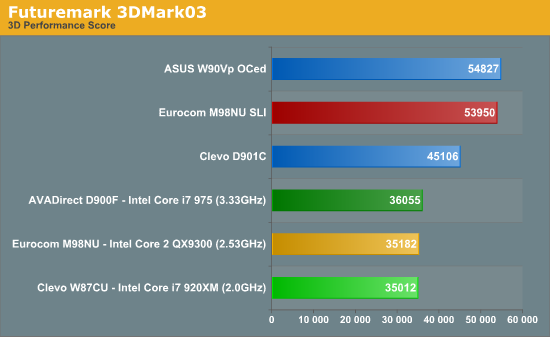
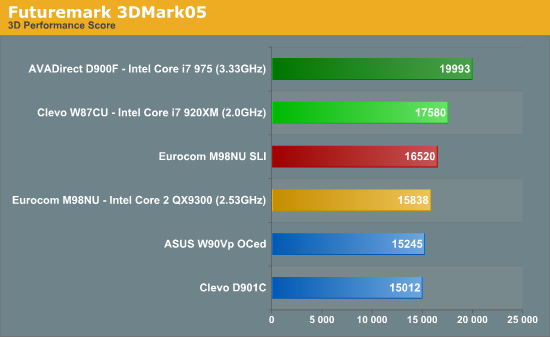
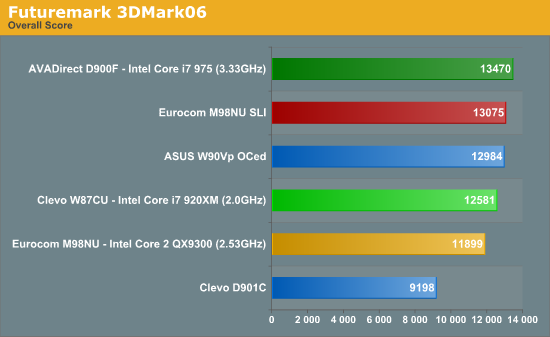
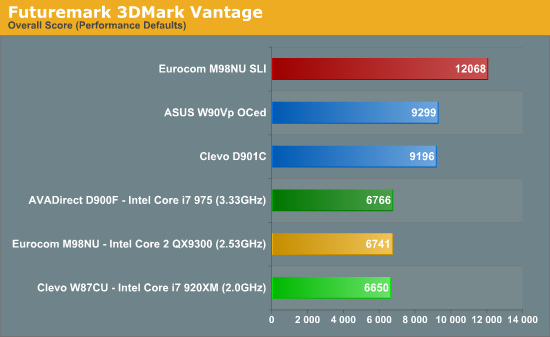
The 3DMark results are scattered, especially in the older titles. The ASUS W90Vp has a clear lead in 3DMark03 over everything but the SLI configuration, but the Core i7-based systems turn the table in 3DMark05. There they manage to outperform everything including the dual GPU configurations. 3DMark06 still has the D900F in the lead, but the dual GPU notebooks are right behind. Once we hit 3DMark Vantage, graphics becomes a far bigger influence on the overall score and the SLI and CrossFire systems jump to the front with all of the GTX 280M setups essentially tied.
Based on 3DMark results, we can guess that gaming performance will favor i7 in certain situations and faster GPUs in others. Let's see if that actually holds true.
Gaming Performance
For this initial look, we've trimmed our usual battery of game tests down to eight titles. We still have one "simulation" (GRID), four first-person shooters, two role-playing games, and one strategy game. All of these gaming tests were run at 1920x1080 using High/Very High detail settings. For the Clarksfield system, this required the use of an external LCD since otherwise we would be limited to 1600x900.
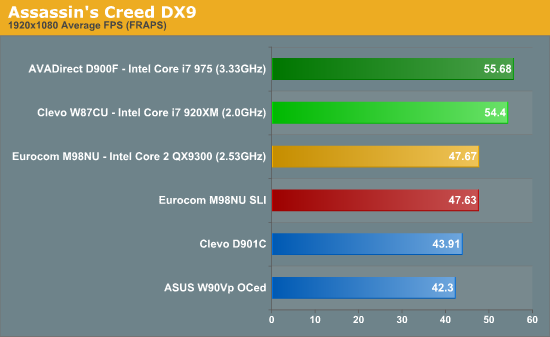
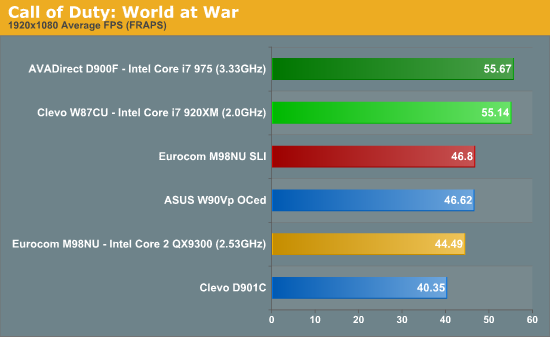
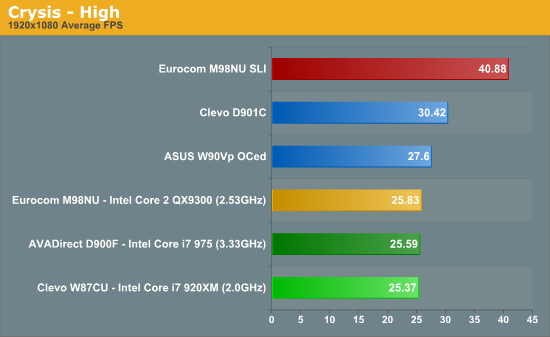
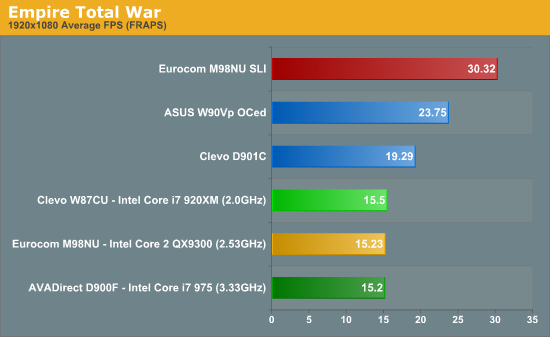
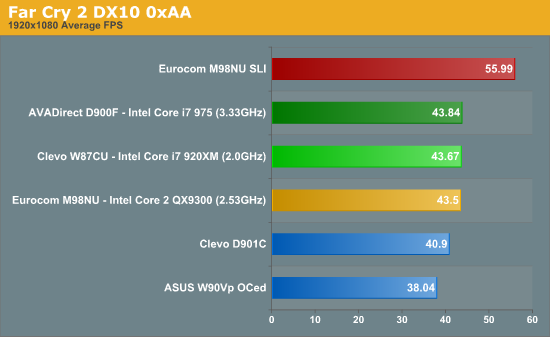
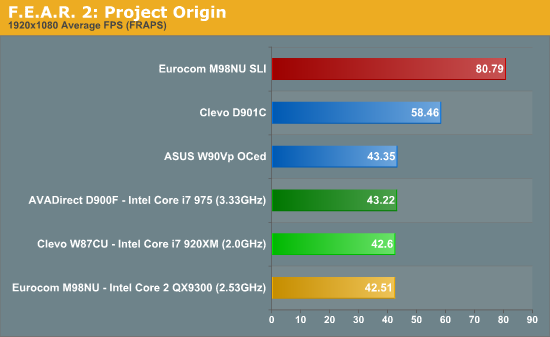
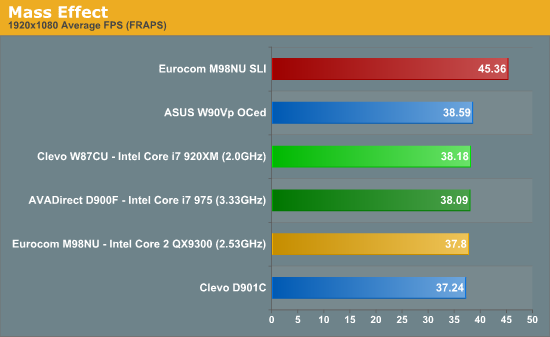
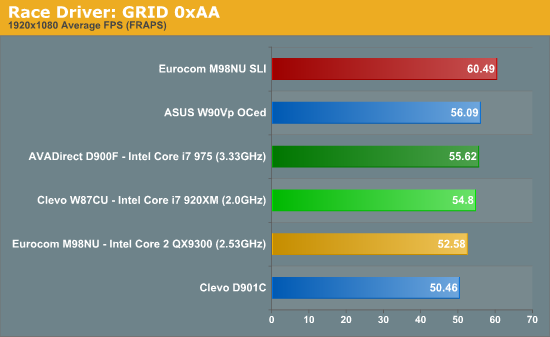
It's clear that we are GPU limited at these settings in some of the titles, but a few games are also clearly CPU limited. Falling into the CPU limited category, Assassin's Creed and Call of Duty: World at War both show similar performance with the i7 systems and show little if any benefit to SLI. The QX9300 in the Eurocom is 15~25% slower than the i7-920XM in these two titles.
Most of the games show a clear benefit for SLI, however, and likewise they show that the GTX 280M is a bottleneck for gaming performance. SLI improved performance by 15% in GRID, 20% in Mass Effect, and almost 30% in Far Cry 2. The big winners for SLI are Crysis (~60% boost from SLI), F.E.A.R 2 (90% boost), and Empire: Total War (99% faster with SLI).
If you're after optimal gaming performance, obviously just getting the fastest CPU or the fastest GPU alone won't cut it in every situation. You need a balanced platform with a CPU and GPU matched to offer the best performance in a large variety of situations. QX9300 with GTX 280M SLI often tips the scales too far towards the GPU side of the equation, while i7-975 is complete overkill for a single GTX 280M (about the level of a desktop 9800 GTX+/GTS 250).
We are definitely interested in seeing what the i7-920XM - as well as the i7-820QM and i7-720QM - can do with SLI graphics in the future. We're also looking forward to the day when we see mobile versions of stuff like the HD 5870, preferably with power gate transistors.
Battery Life and Power
Wrapping up our tests, we have a couple battery life tests as well as results measuring power draw at the outlet. We used our standardized Internet battery life test as well as a best-case test of idle battery life.
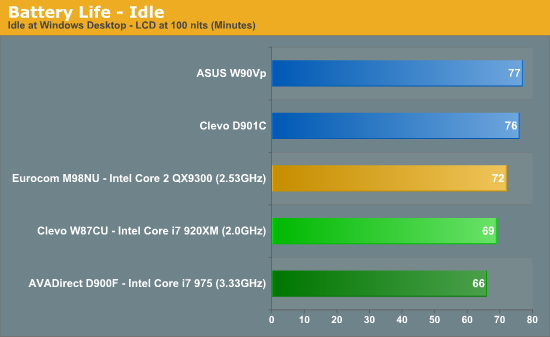
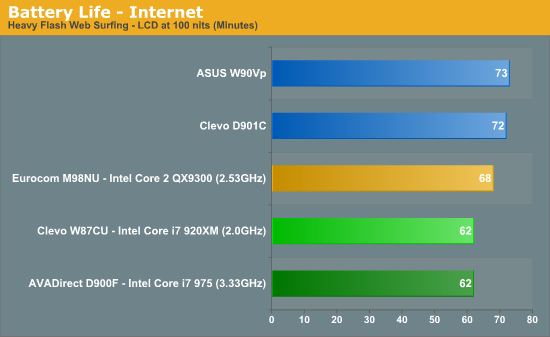
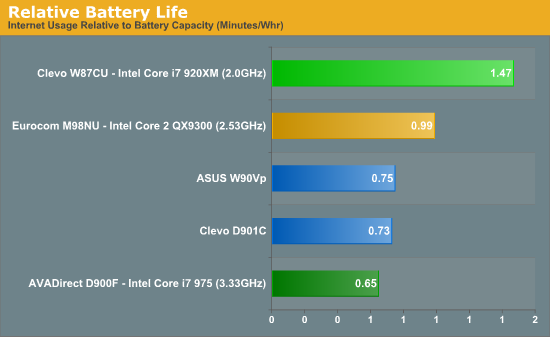
If you only focus on battery life in minutes, Clarksfield looks like a poor solution. Battery life is similar to the much larger Eurocom M98NU and AVADirect D900F. The problem with the comparison is that the W87CU uses a much smaller battery. In our relative battery life chart, we calculated how many minutes of battery life you get relative to battery capacity. Looking at that metric, Clarksfield easily surpasses all of the other previous high-end laptop CPU solutions. The D900F and D901C both use desktop CPUs in a large notebook chassis, and they are at the bottom of the test results with the ASUS W90Vp not far behind. Eurocom ends up providing 33% more battery life per watt hour than the W90Vp, but the big winner is the W87CU, which is 50% better than the next closest competitor.
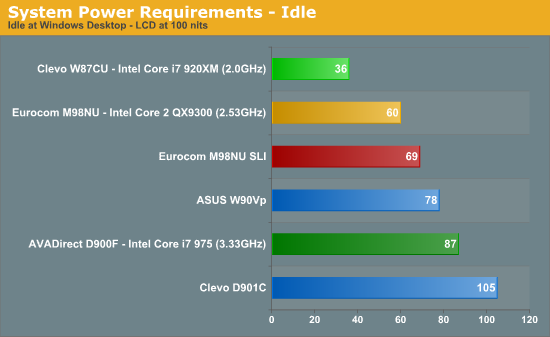
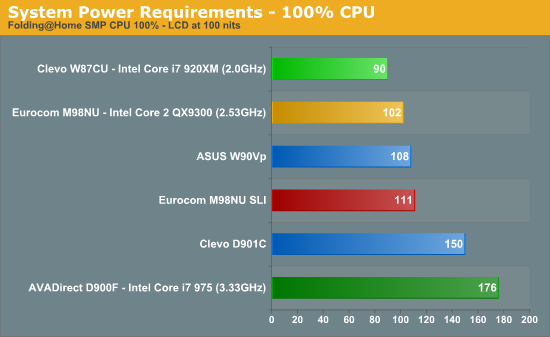
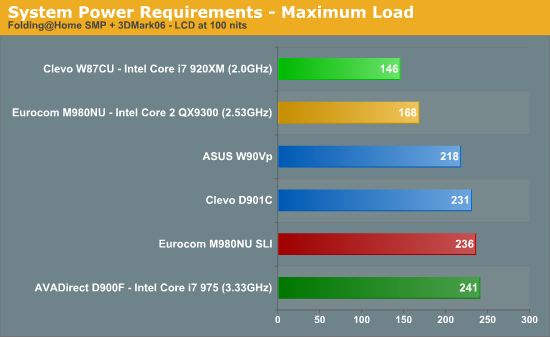
As a corollary to the battery life results, power results pretty much confirm what we see in the relative battery life chart. The Clevo W87CU with Clarksfield CPU uses a lot less power than the other systems. With the graphics card and other components drawing plenty of power, the laptop is by no means a long battery life solution, but with a larger battery and a less power hungry GPU it could certainly last several hours between charges.
What we really want/need is Arrandale, at least if you're after good performance without killing your battery life. i7-920XM has potential to draw very little power, but the maximum CPU load definitely reaches the 55W TDP, making it a poor fit for anything but large desktop replacement notebooks. Arrandale will bring us dual-core + Hyper-Threading on 32nm with maximum TDP of 25W and 35W depending on clock speeds (and probably 17W models as well). Another interesting possibility would be Clarksfield with lower Turbo states, potentially getting down to a 35W or lower TDP.
Initial Thoughts
It's good to finally see an official Nehalem CPU for the mobile sector. Power gate transistors have the potential to seriously improve battery life, and we can't wait to see that sort of technology begin making its way into GPUs and chipsets as well as processors. In terms of performance, things are a little bit of a mixed bag.
Certainly the i7-920XM is a fast processor; the problem is that it's also a relatively power hungry processor, and without a larger battery users of the W87CU can expect roughly the same one hour of battery life you get with other desktop replacements. As long as you understand you're getting a desktop replacement, however, the W87CU should work fine. The real problem isn't competition from the mobile sector per se, but rather the notebooks that use desktop CPUs - specifically desktop i7 CPUs. If you don't care that much about battery life, wouldn't you rather have a desktop replacement with a $1000 Core i7-975 instead of a $1000 Core i7 920? If you're wealthy it probably doesn't matter much, but the rest of us will need to think very carefully about how much we want a faster laptop before taking the Clarksfield plunge. For CPU intensive tasks, the AVADirect D900F system can easily outperform a W87CU for about the same price (though it does weigh more).
If there's anything Clarksfield shows us, it's that we really want Arrandale - sooner rather than later. Quad-core processors simply aren't a major need for the vast majority of laptop users, and the higher prices and higher maximum TDP make them less desirable. Arrandale should do a great job at addressing both of those shortcomings, and the same goes for Clarkdale on the desktop. Lower power dual-core processors with Hyper-Threading will still have the ability to run four simultaneous threads, and they should also be able to run at higher clock speeds most of the time.
We will have additional benchmark results and discussion of the pros and cons of the various laptops tested in this article in the near future. Considering pricing is similar on all three models, however, users will need to decide what they want most. Mobile gamers will definitely want something with dual graphics capability, and content creators will prefer something similar to the D900F. The question is, who fits in the middle? Clarksfield could go either way, offering a reasonable blend of CPU performance and power requirements. It's almost inevitable that we will see Clarksfield laptops in the future that also offer dual GPUs, at which point we might be onto the next Intel "Tock". However you look at it, high-end laptop users just got some new choices, and freedom of choice is always a good thing.








No comments:
Post a Comment